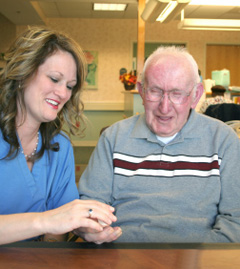
Preventing One of the Most Catastrophic Events in the Life of a Senior Citizen
The fastest growing segment of our population is the 85 and over age group. Many seniors want to remain in the comfort and security of their own homes. This means that many of us have some responsibility for caring for elderly parents, relatives, friends and neighbors. Family members are the largest group of caregivers. 25 million Americans (many with children and jobs), provide 80% of the home care. More than 7 million Americans care for relatives hundreds or thousands of miles away.
One of the greatest fears among senior citizens is the fear of falling. Fear of falling leads to lost confidence and increased inactivity. This is not an irrational fear as falling is a primary catalyst for hospital admissions among seniors. Helping seniors reduce their risk of falling is one of the most positive things that we can do for seniors.
Consider the following startling statistics:
- Falls are responsible for 40% of the admissions to nursing homes.
- 70% of accidental deaths in people over 75 years of age are caused by falls.
- One in three older adults living at home falls each year (this considers only those falls that result in reported medical care).
- Injuries from falls result in medical costs of $70 billion each year. The human costs are even greater as individuals, caregivers and families are all impacted by a fall.
Falls are caused by internal as well as external factors. Internal factors such as slowed reflexes, balance disorders, weakness, muscle tightness, reduced flexibility, cognitive impairments, low blood pressure and visual deficits all contribute to the risk of falling. Controllable external factors including effects of medications, poor lighting, cluttered living spaces, lack of handrails, unstable chairs and rugs that aren™t secured are just some of the factors that can lead to a devastating fall. Osteoporosis can significantly increase the chances of serious injury resulting from a fall.
The good news is that most falls can be prevented. The first step is to make an honest assessment of the risk that your loved one has for experiencing a debilitating fall. A good first step is to complete, the Fall Risk Self-Assessment.
| FACTOR |
CRITERIA |
SCORE |
|
| AGE |
60-70 YEARS |
1 |
|
71-80 YEARS |
2 |
|
81 YEARS AND UP |
3 |
|
| HOSPITALIZED IN THE PAST 12 MONTHS |
YES |
1 |
|
NO |
0 |
|
| MENTAL ACUITY |
FORGETFUL |
1 |
|
IMPULSIVE |
2 |
|
DISORIENTED |
3 |
|
| GAIT & MOBILITY |
NO ASSISTIVE DEVICES |
0 |
|
USES CANE/WALKER |
1 |
|
| LOSS OF BALANCE/WEAKNESS |
OCCASIONALLY |
1 |
|
OFTEN |
2 |
|
FALL IN LAST 3 MONTHS |
3 |
|
| ELIMINATION |
SENSE OF URGENCY |
1 |
|
REQUIRE ASSISTANCE |
2 |
|
INCONTINENCE |
3 |
|
| MEDICATIONS |
Currently taking antidepressants or medications that may impair thought process, cause vertigo, lower blood pressure, cause central nervous system alterations |
1 |
|
Laxatives or diuretics |
2 |
|
| TOTAL POINTS |
0 “ 5 Points = Low Risk 6 “ 8 points = Moderate Risk 8 + Points = High Risk
Other actions that will help reduce the risk of falling are:
- Tell the healthcare provider if a fall has occurred in the last year and if so the circumstances of the fall.
- Make sure doctors and pharmacists are aware of all medications being taken.
- Tell the healthcare provider if any weakness in the legs or any other problems with the legs or feet are experienced.
- Make sure doctors are aware of any vision or hearing loss.
- Perform a complete home safety inspection to assess overall safety as well as things such as lighting, flooring and furniture placement.
- Obtain in-home help for tasks that have become dangerous and difficult.
Many seniors can remain safely in their own home with a little bit of help. Many times an outside agency can provide a caregiver that will go to the senior™s home and help complete tasks that are difficult for the senior to perform. Chores such as light housekeeping, laundry, meal preparation, assistance with bathing and grooming, medication reminders and incidental transportation are just some of the services that a caregiver can provide. The result is a happier senior, in a safer environment with less stress on family caregivers.
The bottom line is that seniors need to stay connected and continue to do what they like to do, for as long as possible. One of the best ways to accomplish this is to keep seniors on their feet by avoiding falls.